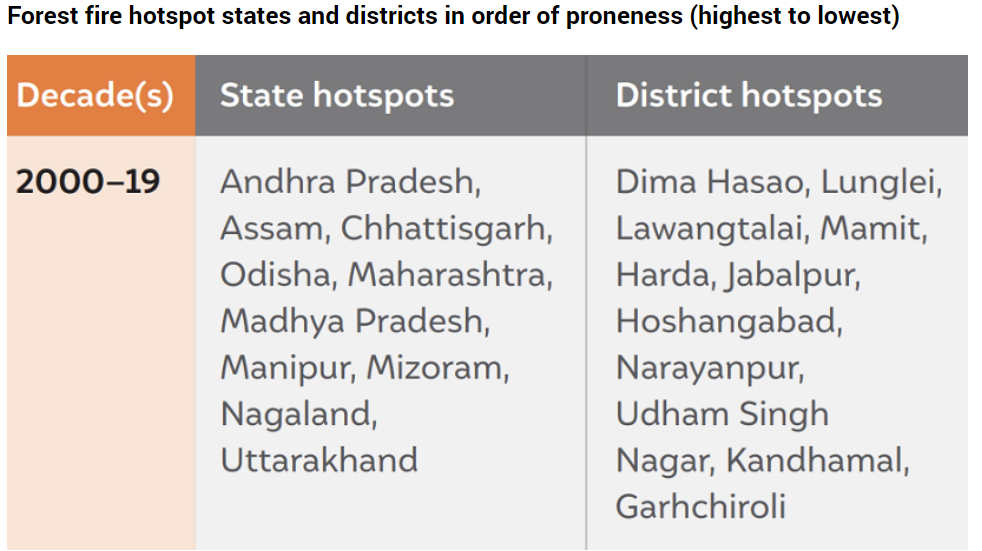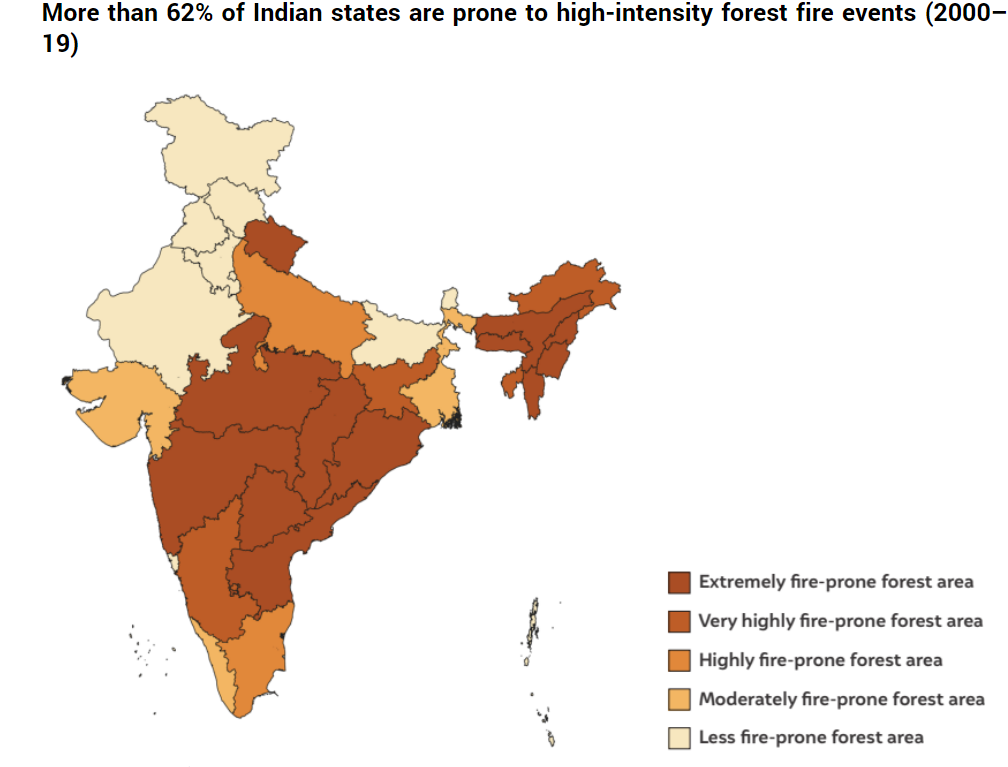Biodiversity & Environment
Managing Forest Fires in a Changing Climate
- 09 Apr 2022
- 6 min read
For Prelims: Forest Fires, Climate Change, National Action Plan on Forest Fires, Council on Energy, Environment and Water, NDMA, Forest Survey Report.
For Mains: Causes of Forest fires and Challenges in Coping with it.
Why in News?
According to a study(Managing Forest Fires in a Changing Climate) released by the Council on Energy, Environment and Water (CEEW), the frequency and intensity of forest fires, as well as the number of months in which such fires occur, have increased in the past two decades.
- CEEW is an independent, non-partisan, one of Asia’s leading not-for-profit policy research institutions, devoted tbo research on all matters affecting the use, reuse, and misuse of resources.
What are the Forest Fires?
- Also called bush or vegetation fire or wildfire, it can be described as any uncontrolled and non-prescribed combustion or burning of plants in a natural setting such as a forest, grassland, brush land or tundra, which consumes the natural fuels and spreads based on environmental conditions (e.g., wind, topography).
- Forest Fires can be incited by human actions, such as land clearing, extreme drought or in rare cases by lightning.
- There are three conditions that need to be present in order for a wildfire to burn: fuel, oxygen, and a heat source.
What are the Findings?
- Increase in Forest Fires:
- There has been a ten-fold increase in forest fires in the past two decades, and more than 62% of Indian states are prone to high-intensity forest fires.
- Andhra Pradesh, Assam, Chhattisgarh, Odisha and Maharashtra are the most prone to high-intensity forest fire events caused by rapid change in climate.
- Mizoram has had the highest number of forest fire incidences in the last two decades, with more than 95% of its districts being forest fire hotspots.
- Districts that were earlier flood prone have now become drought prone due to a “swapping trend” as a result of climatic changes.
- More than 75 % of Indian districts are extreme climate event hotspots, and more than 30 % of districts are extreme forest fire hotspots.
- More Incidences in the Northeast:
- Most of the NER (northeastern region) are witnessing an increased frequency of forest fire incidences in recent decades.
- Despite the NER being a rain-fed area, it is witnessing more forest fire incidences during increased dry spells across March-May and due to the muddled rainfall distribution pattern.
- Prolonged Duration of Incidences:
- Earlier, forest fires would take place during the summer months, that is between May and June. Now, during spring, between March and May, because of climatic changes.
- The duration that forest fires could take place was two to three months earlier, but it is now nearly six months.
- A Forest Survey of India report in 2019 found that 36 % of forest cover in India falls in zones that are prone to forest fires.
What is the Recent Data on Forest Fires?
- A total of 381 forest fires have been reported in India by 30th March, 2022, according to the Forest Survey of India. Madhya Pradesh has recorded the highest number of fires at 133.
- In March 2022, significant forest fires were reported in states such as Uttarakhand, Madhya Pradesh and Rajasthan.
- The recent fire at Rajasthan’s Sariska Tiger Reserve was also considered to have been unseasonal, with high temperatures exacerbating the spread of the fire.
- January 2021 saw prolonged fires in Uttarakhand, Himachal Pradesh (Kullu Valley) and Nagaland-Manipur border (Dzukou Valley)
- Recent fires also include those in Bandhavgarh Forest Reserve in Madhya Pradesh.
What are the Recommendations of CEEW?
- Recognise as a Disaster:
- The forest fires should be treated as “natural disasters” and be brought under the National Disaster Management Authority.
- Moreover, by designating forest fires as natural disasters, there will also be a financial allotment made to manage them.
- Develop Alert system:
- A forest fire only alert system needs to be developed that can provide real time impact-based alerts.
- Enhance Adaptive Capacity:
- Capacity-building initiatives targeted at district administrations and forest-dependent communities can avert the extent of loss and damage due to forest fires.
- Provide Clean Air Shelters:
- The state government/ state forest departments (SFDs) should repurpose public buildings like government schools and community halls by fitting them with clean air solutions – like air filters – to create clean air shelters for communities worst impacted by fires and smoke from forest fires.
What are the Efforts to Mitigate Forest Fires?
- Since 2004, the FSI (Forest Survey of India) developed the Forest Fire Alert System to monitor forest fires in real time.
- National Action Plan on Forest Fires (NAPFF) 2018 and Forest Fire Prevention and Management Scheme.








